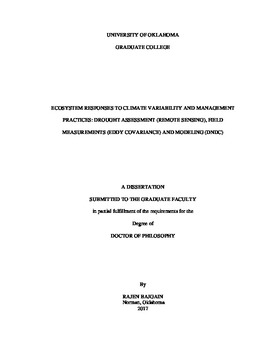| dc.description.abstract | Climate variability and management practices in isolation or in combination influence the properties of ecosystems and the flows of energy and materials through them. The goal of this dissertation is to better understand the ecosystem responses to climatic variability and management practices using different approaches such as remote sensing, eddy covariance techniques and modelling. Remote sensing indices were tested and evaluated for developing better drought monitoring. Specifically, water related vegetation index (LSWI) was employed to assess the ecosystem responses to the drought events occurred in Oklahoma from 2000-2013. Field measurements data in combination with the EC system were used to understand how the sink-source potential of the ecosystem changes when grassland ecosystem is converted to winter wheat.
DeNitrification- DeComposition (DNDC) model was used to analyze greenhouse gas emissions from pasture land amended with fertilizers compared to the native pastures in the scenario of climatic variability. We used 14 years of MODIS, Mesonet soil moisture and rainfall data at Marena and El Reno tallgrass prairie sites to study the impact of drought events on grassland phenology and growth through analyzing sensitivity differences of vegetation indices to drought. A new approach of drought assessment, counting number of days with LSWI < 0 and LSWI-based drought severity classification, is proposed in this study. The number of days with LSWI < 0 was found higher during the summer droughts of 2006 and 2012 and negative LSWI represented the higher intensity drought categories (D2, D3 and D4) defined by USDM, which demonstrated that it could be used to describe the hydrological condition of the ecosystem as an effective additional vegetation based indicator for drought assessment. This study also investigates the potential of the LSWI-based algorithm, for agricultural drought monitoring under varying soil and land cover conditions of 113 Mesonet stations of Oklahoma. We compared LSWI and the number of days with negative LSWI (DNLSWI) to summer time precipitation, precipitation anomalies, and the U.S. Drought Monitor. Additionally, the assessment of the algorithm with USDM was performed separately for different land cover type and climate divisions. Therefore, results from this study will help in improving the capability of remote sensing vegetation drought monitoring by establishing LSWI as a complimentary tool to existing NDVI based drought products as well as help to identify the sensitivity of LSWI to the diversity of the ecosystems of Oklahoma.
We quantified and compared the carbon and water fluxes from winter wheat and tallgrass prairie ecosystems and discussed the possibility of change in carbon and water budgets of the southern plains under the land use change scenario (conversion of grassland into winter wheat). Both ecosystems were sinks of carbon during their respective growing seasons. At the annual scale, the wheat ecosystem was a net source of carbon (128 ± 46 g C m-2 yr-1) when fluxes from summer fallow period were considered. Results suggest that the differences in magnitudes and patterns of CO2 and H2O fluxes between winter wheat and tallgrass prairie ecosystems can exert an influence on the carbon and water budgets of the whole region under land use change scenario. Another hypothesis tested in our study was that the application of fertilizers in the managed pasture would increase the primary productivity of the ecosystem for few years but this increase in carbon sink would be counteracted by the increasing rate of greenhouse gas emissions in the long run. Here we used DNDC, a process-based model that simulates the emissions and consumption of gases within the ecosystem based on the interactions of local climate, local soils and on-site management practices. The fertilization of pasture increased the productivity that increased the roughages demands resulted by increased stocking density of cattle. Similarly, higher flux of N2O from the managed pasture was resulted as the effect of fertilizer addition which amplified in magnitude in wet years than dry and normal years. The advantage from increased soil organic carbon due to the fertilizer application, measured in terms of global warming potential (GWP) was outweighed by the GWP calculated from the increased magnitude of N2O fluxes thereby giving the positive net global warming potential (NGWP). Therefore, pasture management policies should consider maintaining emissions level as minimum as possible while optimizing the productivity. | en_US |
